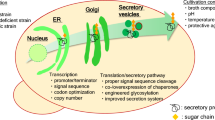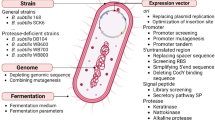Abstract
The pentafunctional AROM protein in Aspergillus nidulans and other fungi catalyses five consecutive enzymatic steps leading to the production of 5-enolpyruvylshikimate 3-phosphate (EPSP) in the shikimate pathway. The AROM protein has five separate enzymatic domains that have previously been shown to display a range of abilities to fold and function in isolation as monofunctional enzymes. In this communication, we report (1) the stable overproduction of a bifunctional protein containing the 3-dehydroquinate (DHQ) synthase and EPSP synthase activities in Escherichia coli to around 10% of the total cell protein; (2) that both the DHQ synthase and EPSP synthase activities in the over-produced fragment are enzymatically active as judged by their ability to complement aroA and aroB mutants of E. coli; (3) that the EPSP synthase domain is only enzymatically active when covalently attached to the DHQ synthase domain (the cis arrangement). When DHQ synthase and EPSP synthase are produced concomitantly by transcribing sequences encoding the individual domains from separate plasmids in the same bacterial cell (the trans arrangement) no overproduction or enzyme activity can be detected for the EPSP synthase domain; (4) the EPSP synthase domain can be stably overproduced as a fusion protein with glutathione S-transferase (GST), however the EPSP synthase in this instance is enzymatically inactive; (5) a protein containing an enzymatically inactive DHQ synthase domain in the cis arrangement with EPSP synthase domain is stably overproduced with enzymatically active EPSP synthase; (6) the two C-terminal domains of the AROM protein specifying the 3-dehydroquinase and shikimate dehydrogenase domains can be overproduced in A. nidulans using a specially constructed expression vector. This same bi-domain fragment however is not produced in E. coli when identical coding sequences are transcribed from a prokaryotic expression vector. These data support the view that multifunctional/multidomain proteins do not solely consist of independent units covalently linked together, but rather that certain individual domains interact to varying degrees to stabilise enzyme activity.
Similar content being viewed by others
References
Anton IA, Duncan K, Coggins JR (1987) A eukaryotic repressor protein, the qa-1s gene product of Neurospora crassa is homologous to part of AROM multifunctional enzyme. J Mol Biol 197:367–371
Biggin MD, Gibson T, Hong CF (1983) Buffer gradient gel and 35S label as an aid to rapid DNA sequence determination. Proc Natl Acad Sci USA 80:3963–3965
Blattner FR, Williams, BG, Blechl AE, Denniston-Thomson K, Faber H, Furlong L, Grunwald DJ, Keifer DO, Moore DD, Schumm JW, Sheldon EL, Smithies O (1977) Charon phages: safer derivatives of bacteriophage lambda for DNA cloning. Science 196:161–169
Case ME, Burgoyne L, Giles NH (1969) In vivo and in vitro complementation between dehydroquinate synthase mutants in the arom cluster gene of Neurospora crassa. Genetics 63: 581–588
Charles IG, Keyte JW, Brammar WJ, Smith M, Hawkins AR (1986) The isolation and nucleotide sequence of the complex arom locus of Aspergillus nidulans. Nucleic Acids Res 14:2201–2213
Coggins JR, Boocock MR, Chaudhuri S, Lambert JM, Lumsden J, Nimmo GA, Smith DDS (1987) The AROM multifunctional enzyme from Neurospora crassa. Methods Enzymol 142:325–341
Garbe T, Servos S, Hawkins AR, Dimidriadis G, Young D, Dougan G, Charles I (1991) The Mycobacterium tuberculosis shikimate pathway genes: evolutionary relationship between biosynthetic and catabolic 3-dehydroquinases. Mol Gen Genet 228:385–392
Grant S, Roberts CF, Lamb HK, Stout M, Hawkins AR (1988) Genetic regulation of the quinic acid utilization (qut) gene cluster in Aspergillus nidulans. J Gen Microbiol 134:347–358
Hawkins AR (1987) The complex arom locus of Aspergillus nidulans: evidence for multiple gene fusions and convergent evolution. Curr Genet 11:491–498
Hawkins AR, Smith M (1991) Domain structure and interaction within the pentafunctional AROM polypeptide. Eur J Biochem 196:717–724
Hawkins AR, Giles NH, Kinghorn JR (1982) Genetical and biochemical aspects of quinate breakdown in the filamentous fungus Aspergillus nidulans. Biochem Genet 20:271–286
Hawkins AR, Lamb HK, Smith M, Keyte JW, Roberts CF (1988) Molecular organisation of the quinic acid utilisation (qut) gene cluster in Aspergillus nidulans. Mol Gen Genet 214:224–231
Hawkins AR, Lamb HK, Roberts CF (1992) Structure of the Aspergillus nidulans qut repressor-encoding gene: implications for the regulation of transcription initiation. Gene 110: 109–114
Hemsley A, Arnheim N, Toney MD, Cortopassi G, Galas DJ (1989) A simple method for site-directed mutagenesis using the polymerase chain reaction. Nucleic Acids Res 17:6545–6551
Kinghorn JR, Hawkins AR (1982) Cloning and expression in Escherichia coli K-12 of the biosynthetic dehydroquinase function of the arom cluster gene from the eukaryote Aspergillus nidulans. Mol Gen Genet 186:145–152
Kleanthous C, Deka R, Davis K, Kelly SM, Cooper A, Harding SE, Price NC, Hawkins AR, Coggins JR (1992) A comparison of the enzymological and biophysical properties of two distinct classes of dehydroquinase enzymes. Biochem J 282:687–695
Kunkel TA (1985) Rapid and efficient site specific mutagenesis without phenotypic selection. Proc Natl Acad Sci USA 82:488–492
Lamb HK, Bagshaw CR, Hawkins AR, (1991) In vivo overproduction of the pentafunctional AROM polypeptide in Aspergillus nidulans affects metabolic flux in the quinate pathway. Mol Gen Genet 227:187–196
Lamb HK, Roberts CF, Hawkins AR (1992a) A second gene within the quinic acid gene cluster in Aspergillus nidulans encodes a putative zinc cluster motif. Gene 112:219–224
Lamb HK, van den Hombergh JPTW, Newton GH, Moore JD, Roberts CF, Hawkins AR (1992b) Differential flux through the quinate and shikimate pathways: implications for the channelling hypothesis. Biochem J. 284:181–187
Maniatis T, Fritsch EF, Sambrook J (1982) Molecular cloning: a laboratory manual: Cold Spring Harbor Laboratory Press, Cold Spring Harbor, New York
Matthes WD, Zenke W, Grundstrom T, Staub A, Winterzerith M, Chambon P (1984) Simultaneous rapid chemical synthesis of over one hundred oligonucleotides on a micro scale EMBO J 3:801–805
Moore JD, Lamb HK, Garbe T, Servos S, Dougan G, Charles IG, Hawkins AR (1992) Inducible overproduction of the Aspergillus nidulans pentafunctional AROM protein and the type I and II 3-dehydroquinases from Salmonella typhi and Mycobacterium tuberculosis. Biochem J 287:173–181
Pittard AJ (1987) Biosynthesis of the aromatic amino acids. In: Neidhardt FC, Ingraham JL, Low KB, Magasanik B, Schaechter M, Umbarger HE (eds) Escherichia coli and Salmonella typhimurium: cellular and molecular biology, vol 1. American Society for Microbiology, Washington, DC, pp 368–394
Sanger F, Nicklen S, Coulson AR (1979) DNA sequencing with chain-terminating inhibitors. Proc Natl Acad Sci USA 74:5463–5467
Shneier A, Harris J, Kleanthous C, Coggins JR, Hawkins AR, Abell C (1993) Evidence for opposite stereochemical courses for the reactions catalysed by type I and II dehydroquinases. Bio-org Med Chem Lett, in press
Sproat BS, Gait MJ (1985) Chemical synthesis of a gene for somatomedin C. Nucleic Acids Res 13:2959–2988
Tautz D, Renz M (1982) An optimised freeze squeeze method for the recovery of DNA fragments from agarose gels. Anal Biochem 132:14–19
van den Hombergh JPTW, Moore JD, Charles IG, Hawkins AR (1992) Overproduction in Escherichia coli of the dehydroquinate synthase domain of the Aspergillus nidulans pentafunctional AROM protein. Biochem J 284:861–867
Willetts NS, Clark AJ, Low B (1969) Genetic location of certain mutations conferring recombination deficiency in Escherichia coli. J Bacteriol 97:244–249
Author information
Authors and Affiliations
Additional information
Communicated by W. Gajewski
Rights and permissions
About this article
Cite this article
Moore, J.D., Hawkins, A.R. Overproduction of, and interaction within, bifunctional domains from the amino- and carboxy-termini of the pentafunctional AROM protein of Aspergillus nidulans . Molec. Gen. Genet. 240, 92–102 (1993). https://doi.org/10.1007/BF00276888
Received:
Accepted:
Issue Date:
DOI: https://doi.org/10.1007/BF00276888




